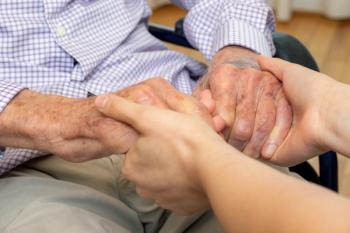
Women in Health IT Weigh in on HIMSS 2019
Janae Sharp explores what some of the top women in health tech took away from a conference where just 33 percent of attendees were female.
Thumbnail has been altered. Credit: Oscar & Associates for HIMSS.
Looking back at HIMSS 2019, it’s exciting to realize what a great platform the conference was for women in health IT. One of the panels I was most excited and honored to participate in focused on #BalanceForBetter; for me, this had a personal connection, as this HIMSS conference was truly a balancing act. My little one turned 3 months old on the first day of HIMSS — and he came with me to the conference.
During our panel, we reviewed the percentage of women attending the conference, which was lower than I would have guessed, probably because not everyone could feasibly bring their children along. While I realize a newborn parent doesn’t represent most people who will read this article, it was my personal barrier. Moms seem to be low-hanging fruit in the barrier coverage, and I understand why. It felt impossible to do everything.
>> READ:
With that in mind, I spoke to some of the women who were featured at HIMSS 2019 about the future of women in Health IT. What progress, if any, has the industry made? What still needs to be done? And how did HIMSS '19 represent the state of women in health IT?
Here’s what they said.
Lygeia Ricciardi, Chief Transformation Officer, Carium
I feel very fortunate to have received an award for Most Influential Women in Health IT at HIMSS 2019. Over the course of the week, as I participated in multiple events focused on women in our industry, my attitude toward the award evolved. Although I first thought of it primarily as an honor, I began to see it as a responsibility. I spoke with and listened to many women, at a variety of stages, on their respective careers.
There were so many commonalities in our experiences and challenges, navigating our professional lives. The award gives me a platform to encourage other women and to educate both women and men about how we can achieve greater diversity, especially among leadership in health IT. It’s a serious responsibility. If I don’t speak up, who will? It’s not like anyone needs an award to speak their mind, but now I feel I particularly owe it to the many women out there, like Moji (pictured here) a talented and driven student who could benefit a lot from some practical advice and a strong dose of encouragement from someone else who’s been in her shoes.
Bridget Duffy, M.D., Chief Medical Officer, Vocera
It was encouraging to see more people and organizations at HIMSS 2019 talking about the importance of clinician burnout and well-being this year. It was also good to see several female speakers leading sessions. Vocera and our Experience Innovation Network have been working with Sue Murphy, R.N., chief experience officer at UChicago Medicine, for many years, and it is inspiring to see her take the HIMSS stage two years in a row, sharing
I would love to see more women take the stage at HIMSS and other industry conferences. I am on a mission to get more women up front at HIMSS, in leadership roles and on healthcare technology boards. When I am asked to speak at events, I insist that faculty be at least 51 percent female. [Note: Only 33 percent of HIMSS attendees were women.] Seeing Murphy speak, in essence, represented two major goals: advancing diversity in our field and mentoring the next generation of healthcare leaders, who both embody values that restore humanity to healthcare and advocate for those who cannot.
Tamara StClaire, Ph.D., Chief Strategy and Innovation Officer, Guidewell
During HIMSS '19, I was struck with the impact of the bias multiplier. That is the magnified effect that bias can have downstream. Health economist Jane Sarasohn-Kahn spoke about how implicit bias deep inside of an algorithm developer, who codes and collects and selects data for training, can reveal personal values in the ultimate outcome.
>> READ:
This might sound benign, but the results have been pretty scary. One alarming example showed that Google’s search algorithm displayed
We also see this bias multiplier evidenced in the number of women represented in executive ranks in healthcare. Women constitute 80 percent of healthcare decision making, make up about 70 percent of the healthcare workforce, and occupy only about 35 percent of leadership roles and just 13 percent of healthcare CEOs. Most CEOs come from male-dominated fields like finance, operations or other technical fields. We have an intrinsic bias around the experience that’s required for top leaders. In addition to stacking women’s roles in finance, ops, etc., we need to value different perspectives and experiences that can contribute to a stellar leader at the top.
Overall at HIMSS '19, I learned that we need to move pretty far upstream as we think about implicit bias to change the way we think about diversity and values, subtly even, to start to erode the negative effect this has downstream.
What I Learned from HIMSS 2019
As I spoke with these women whom I respect and have learned so much with, I wanted to make sure that the momentum and relationships that I formed at HIMSS continue.
As for my little guy, he started to roll over on his own the day after we got home.
One of the most hopeful and informative experiences for me this year at HIMSS was a very personal one: I saw the real-life balance of trying to be all things at once. I needed to bring baby to a few sessions (which I was hoping that he would sleep through). I wanted him to be able to have care, but also minimize his exposure to germs. I could not have done it without friends like Ashley Dauwer, of Carium. The things is, so many people helped me that I feel self-conscious thanking her alone. But during my presentation, as I wanted to cry about not being able to do everything, she stood up and held an upset baby who was a bit cranky because he wanted to eat.
The hope I bring from HIMSS is that there were so many people who stood up when I needed them — and that women as a whole have a great many opportunities for game-changing contributions to the field of Health IT.
Get the best insights in healthcare analytics
Related








































